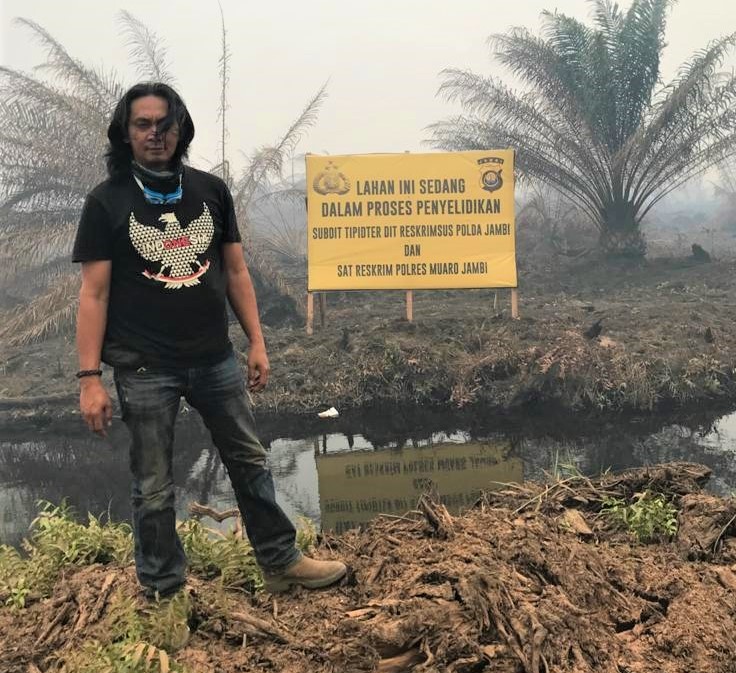What about the One Million Illegal Oil Palm Plantations in Riau?
By Romes IrawanRecurring Peat Fires, Evaluation of the Permitting Process is Needed
In 2020, the Jambi Provincial Regional Disaster Management Agency (BPBD) has created a list that mapped at least 258 villages located in the land and forest fire-prone areas. More than 100 villages are located in peat areas in the West Tanjung Jabung, East Tanjung Jabung and Muaro Jambi District. These villages are usually located around the company concession areas and oil palm plantations areas.
Our observations indicate that the land clearance for oil palm plantations and issuing HTI permits have damaged and drained the peat. Oil palms require a lot of water and cannot grow well in wet conditions, which makes them unsuitable to be cultivated in the peat areas.
The government as the authority holder should take part in protecting the peat by issuing regulations supporting the peat protection efforts, e.g. requiring the concession holders to only cultivate peat-friendly plants or endemic plants. Instead of destroying the peatland for the sake of investment.
Data from the Indonesian Forum for the Environment (Walhi) – Jambi shows that approximately 70 percent of the total 751,000 hectares of peatland in Jambi have been issued concession permits for oil palm plantations and HTI. Hundreds of canals were built by the company to drain the peat. As a result, numerous peat domes were damaged and are now prone to fire.
In early 2016, the government had actually started on the right path by establishing the Peat Restoration Agency (BRG) to restore the damaged peat area. Unfortunately, the government is still acting half-heartedly. The fact is that BRG cannot fully intervene in the company's concession area. It is not surprising that peat damage continues to this day.
KKI Warsi’s, an environmental NGO in Jambi, documentation also shows poor protection for the peat areas. At least more than 20 of the company's concession areas have experienced recurring fires in 2019, with most fires occurring in the concession areas located in the peat areas. This should be an important note for the government to take firm action.
The local governments have always been sluggish in dealing with large companies involved in forest and land fires. The local government never dared to take firm action to create a deterrent effect. Instead, they always relied on the central government.
As a result, the forest and land fires cases handling have been going very slowly. For example, the 2015 fires involving these companies have not been concluded in 2020. The local government's weak attitude has admittedly contributed to the recurring fires in Jambi.
The government must immediately evaluate all permits that have been granted in peat areas if it wants to seriously deal with forest and land fires. Companies that are proven to be negligent must be given firm sanctions in the form of permit revocation to create a deterrent effect. This will affect investments, but the government should prioritize the well-being of its citizens over the economy.
The Threats of Forest and Land Fires in 2020
The Meteorology, Climatology, and Geophysical Agency (BMKG) in Jambi has issued a warning that the dry season will peak in August. Even though the potential for El Nino is relatively safe this year, that doesn't mean there won't be any fires. The government cannot be complacent.
Prevention efforts by conducting information dissemination to prevent the people from clearing a plot of land by burning have not shown any signs of success. Evidently, there have always been fires breaking out in Jambi in the last five years. Even the 2019 fires seemed to repeat the 2015 disaster. More than 154,000 hectares of land were burned and 60 percent of them were peatlands. The 2019 fires in Jambi are estimated to have cost the state up to Rp 12 trillion.
We have not seen the government coming up with a tactical solution to prevent recurring forest and land fires, although the Jambi Provincial Government has prepared more than 5,000 personnel for forest and land fires related operations. This shows that the government is more reliant on reacting rather than preventing. During the pandemic, it will be difficult to take steps in optimally handling forest and land fires. The stricter health protocols will disrupt the work in the field. Not to mention, the budget cuts and diversions due to COVID-19 and its increasingly widespread impact. It is possible that this year's land and forest fire-related operation funds will be overrun due to the health protocols.
The government should focus on fire prevention in fire-prone peat areas by carrying out thorough re-wetting efforts. The government must be able to pressure all the permit holders to ensure that the peatlands in their concession areas remain wet. Once a fire breaks out in the peat area, it will be difficult to extinguish and the fire will potentially spread. This will not only damage the peatland but also cause a haze disaster.
Learning from Land and Forest Fire Victims
We still remember the red sky in Kumpeh Sub-District, Muaro Jambi District in September 2019. Thousands of hectares of peatland burned out of control. Jambi was shrouded in thick haze for months. Even the air quality in Jambi City was at a dangerous level for several days,
peaking on 16 October 2019, at 08.00 WIB. Data from the Jambi City Environment Office Air Quality Monitoring System (AQMS) showed that the PM 2.5 concentration level reached a dangerous level of 1,618. The air in Muaro Jambi, Jambi's largest peat area, is also at an equally dangerous level.
More than 63,000 Jambi residents were reported to have been infected with URTI due to the haze. Jambi City has the highest number of URTI cases. Data from the Jambi City Health Office from August to the second week of October documented more than 24,000 cases, 60% of the cases were children infected with URTI. Dozens of pregnant women also suffered from the haze.
Poor air quality forced the Jambi City Government to stop all school activities. This step was also carried out by almost all district governments in Jambi.
The impact of forest and land fires does not end here. Four Jambi residents suffered deaths related to the forest and land fires in 2019. In August 2019, Asmara, a member of Manggala Agni Daops Muara Bulian (a fire brigade unit), Batanghari District, died when a tree fell on him while he was looking for water to extinguish a fire in the Senami Village, Km 13 of the Tahura area. Barely a month later, Suparmi, a resident of Rt.08 Matagual Village, Batin XXIV Sub-District, Batanghari District, also met the same fate. A tree fell on the 40-year-old woman while she was trying to extinguish a fire in her rubber plantation.
Ahmad Tang, a 55-year-old male resident of Sei Village. Jambat, Sadu Sub-District, who had acute asthma also died due to the poor air quality during the forest and land fires. Four days earlier, a resident of the Anak Dalam Pangkalan Ranjau Tribe, Bahar Selatan Sub-District, Muaro Jambi District, also died from an asthma attack due to the haze.
Amidst the increasing number of COVID-19 cases, we are worried that forest and land fires will have a far worse impact than the previous years. Given that children, the elderly, and people with respiratory diseases are very vulnerable to the impact of these fires. Amidst a difficult situation, the government must work hard to ensure that the fires could be extinguished.
* The author is the Director of Green Association and Coordinator of Simpul Jaringan Pantau Gambut Jambi
**THIS WRITING WAS PREVIOUSLY PUBLISHED ON THE METROJAMBI.COM ONLINE MEDIA ON 28 JULY 2020**




